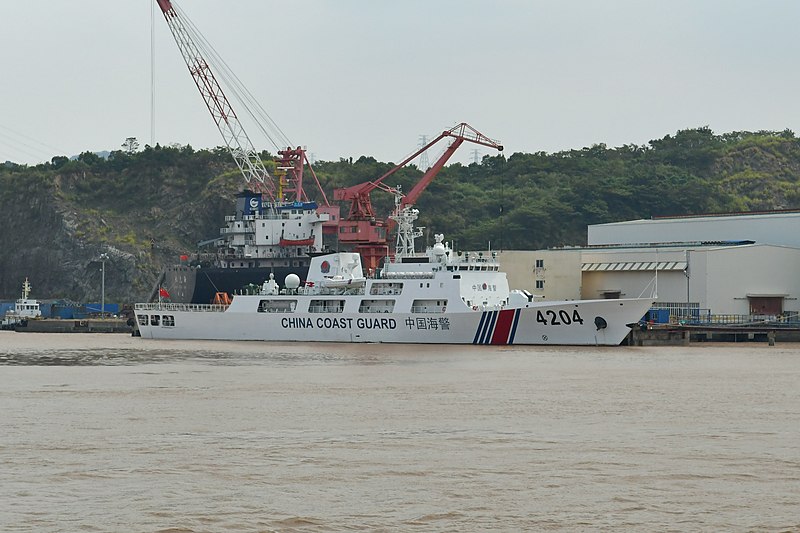
The Philippines has accused China's Coast Guard of launching a "brutal assault" using bladed weapons during a clash in the South China Sea earlier this week.
This incident marks a significant escalation in the ongoing territorial dispute, which could potentially draw the United States into the conflict.
Footage released by the Philippine military on Thursday shows Chinese coast guard officers wielding an axe and other bladed tools at Filipino soldiers and slashing their rubber boat, in what Manila has called a "brazen act of aggression."
Both the Philippines and China have blamed each other for the confrontation near the Second Thomas Shoal in the contested Spratly Islands on Monday. The incident occurred during a Philippine mission to resupply soldiers stationed on a beached World War II-era warship that asserts Manila's territorial claims over the atoll.
This latest incident is part of a series of increasingly tense confrontations in the resource-rich and strategically important waterway. Analysts suggest that China's adoption of more aggressive tactics aims to test the responses of the Philippines and its key defense ally, the United States.
China claims "indisputable sovereignty" over almost all of the South China Sea, including many features that are hundreds of miles from mainland China. Multiple governments, including Manila, hold competing claims.
Collin Koh, a research fellow at the S. Rajaratnam School of International Studies in Singapore, described it as unprecedented for China’s maritime law enforcement to board a Philippine naval vessel. "They can be rubber boats, but it doesn’t change the fact that they are Philippine Navy vessels, and according to international law, they enjoy what we term as sovereign immunity," Koh said. "That is very dangerous because it could even be construed as an act of war."
At a news conference on Wednesday, senior Philippine military officials reported that China's Coast Guard officers "illegally boarded" the Philippine rubber boats, "looted" seven disassembled rifles stored in gun cases, "destroyed" outboard motor, communication, and navigation equipment, and seized personal cellphones from Filipino personnel. Alfonso Torres Jr., commander of the Armed Forces of the Philippines (AFP) Western Command, stated, "They deliberately punctured our rubber boats using knives and other pointed tools."
A Philippine Navy serviceman lost his right thumb when the Chinese Coast Guard rammed the rubber boat, Torres added. China’s Coast Guard also deployed tear gas, "blinding" strobe lights, and continuously blared sirens.
"Only pirates do this. Only pirates board, steal, and destroy ships, equipment, and belongings," Gen. Romeo Brawner Jr., Chief of Staff of the Armed Forces of the Philippines, said in a statement. "The Chinese Coast Guard personnel had bladed weapons, and our personnel fought with bare hands. We were outnumbered and their weapons were unexpected, but our personnel fought with everything that they had."
China's Foreign Ministry, when asked to comment on the allegations, reasserted Beijing’s claims over the Second Thomas Shoal, stating that the Philippine operation was not for humanitarian supplies and accusing Philippine vessels of carrying construction materials and smuggled weapons.
The incident has significant implications for the US, which has a mutual defense treaty with the Philippines dating back decades. The recent clash is the first since a new Chinese law took effect, authorizing its coast guard to seize foreign ships and detain crews suspected of trespassing.
Philippine President Ferdinand "Bongbong" Marcos Jr. has warned that the death of any Filipino citizen at the hands of another country in the waterway would be "very close" to an act of war. The US has reiterated its "ironclad commitment" to the 1951 mutual defense treaty with the Philippines.
US State Department spokesman Matthew Miller stated that the "United States stands with its ally the Philippines and condemns the escalatory and irresponsible actions" by China. In a phone call with Philippine Foreign Minister Enrique A. Manalo, US Secretary of State Antony Blinken underscored the United States' commitments under the mutual defense treaty.
Derek Grossman, a senior defense analyst at the RAND Corporation, noted that the footage clearly shows a Chinese attack on Philippine military assets, which, according to the defense pact, would trigger mutual defense commitments. "However, the Philippines itself would have to initiate a move to activate it before the US would intervene militarily," Grossman said.
In 2016, an international tribunal in The Hague ruled in favor of the Philippines' claims in a landmark maritime dispute, concluding that China has no legal basis to assert historic rights to the bulk of the South China Sea. Despite this, Beijing has ignored the ruling and increasingly pushed its maritime territorial claims.
The decision by China’s Coast Guard to use bladed weapons has drawn comparisons to clashes between China and India on their disputed Himalayan border. The Philippine personnel, elite forces from the Navy Special Operations Group, showed restraint and did not retaliate.
The footage also showed the clash took place next to the BRP Sierra Madre, a rusting Philippine Navy vessel grounded deliberately in 1999 to assert Manila’s territorial claims over Second Thomas Shoal. Koh noted that this is the closest China’s Coast Guard has come to the BRP Sierra Madre.
China's actions appear to be testing the limits of Manila and Washington's responses. "They wanted to see how far the US is willing to pledge its security commitment to the Filipinos," Koh said. "I believe that was a risk they decided to take." Photo by Tyg728, Wikimedia commons.






































